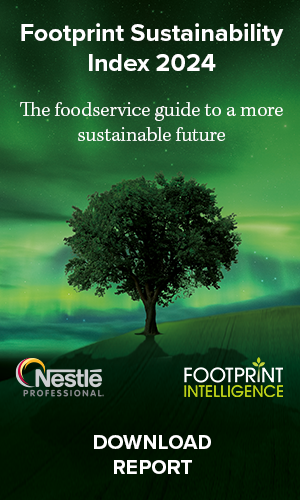Whitney Kakos, Impact & Sustainability Manager at Cafédirect tells Foodservice Footprint about a range of strategies devised to help smallholder farmers of coffee, tea and cocoa cope with changing rainfall patterns.
Smallholder coffee, tea and cocoa farmers represent one of the populations most vulnerable to climate change, and one key change is rainfall patterns. That said, the changes are highly variable by location, so the experiences (and thus adaptation strategies) will differ. Let me give you some examples, writes Whitney Kakos.
Research from our recent AdapCC project (covered in previous issues of Foodservice Footprint) forecasted an overall increase in rainfall over the next 50 years for coffee farmers in Northern Peru, but also a less predictable rainfall pattern with more frequent extreme events such as flooding. For coffee growers in Mexico and Nicaragua, on the other hand, overall rainfall levels will decrease, but they will also face erratic rainfall patterns.
Decreased rainfall threatens the quantity and quality of the coffee harvest, which is mostly watered by rainfall. Unexpected rainfall during the traditional dry season can also disrupt the drying of the coffee beans, which occurs on large patios in the open air, resulting in increased labour and cost for grower organisations. The AdapCC research on tea farming in Kenya found yet another scenario where more frequent drought can damage the tea harvest, which is the farmers sole source of income, thus threatening the food security for the local community.
Willington Wamayeye, of Gumutindo, Uganda says: I have lived near Mt. Elgon all my life and I have never known the weather to be so unpredictable. Rains now fall heavily for a short period of time and our dry season has got much longer. So while heavy rains are causing landslides because the ground cannot handle the downpours, key water sources for our community like streams are drying up. This is causing big problems for growers. Last year alone we lost about 40 per cent of our coffee production because of climate change.
So what are we doing to help? As a grower-focused organisation with Producer Directors on our Board, we have frequent contact with each of our partner organisations. They tell us that the changing climate is having a significant effect on their farmers, and unfortunately the effects are mostly negative. They range from increasing natural disasters, such as hurricanes affecting cocoa crops in the Dominican Republic, to flooding and landslides affecting coffee growers in Peru and Uganda, to drought affecting tea producers in East Africa.
These events make our business model of direct, long-term partnerships with producers all the more important. We hear first-hand about the issues on the ground and work with producers to tackle them instead of turning our backs and finding a new supplier when the going gets tough. We undertook the AdapCC project because we knew straight from producers that climate change was quickly rising up their list of priorities, so the project aimed to support producers and their communities to become more resilient.
Water conservation
Nearly all the coffee, tea and cocoa producers that we trade with use only precipitation to water their crops. That said, producers are well aware of how climate change is affecting their crops and are taking measures to manage both the lack of water and occasions when too much or too little falls. For example, our tea partner Michimikuru, in Kenya, is facing increasing drought. One aggravating factor was that the local river banks had been planted with fast-growing Eucalyptus trees, which actually consume much more water than native trees. So far, the Eucalyptus trees have been removed and replaced with native tree seedlings along more than 60 km of river banks, and according to producers the rivers are flowing more strongly. On the coffee side our partner CEPICAFE, in Peru, has been training farmers to build living barriers, which are boundaries made of natural materials that help to maintain rainwater, limit soil erosion and prevent landslides.
Drought resistant crops
As part of the AdapCC project, our Kenyan tea partner, Michimikuru, identified drought resistant tea plants as a key adaptation strategy. They developed a link with the Kenyan Agricultural Research Institute, which will hopefully undertake this expensive development, which is certainly out of reach for a smallholder-owned tea factory to do on its own!
As the vast majority of our grower partners across coffee, tea and cocoa use only precipitation to water their crops, all are affected by changing rainfall patterns, but some are more sensitive. Coffee plants require rain at a specific time of year (when the plants are flowering) in order to produce the coffee cherries (which house the beans). If there is a lack of rainfall at this time, farmers can lose much of their annual harvest, which means no income from the crop for an entire year. Cocoa is more flexible and the pods can be harvested over much of the year depending on when the rain comes. As cocoa grows on trees, the deeper roots can more easily reach moisture in the ground. Tea, on the other hand, is a monoculture and not shade- grown like the coffee or cocoa our partners grow, so this makes it highly sensitive to drought.
Each of the regions is experiencing changes in rainfall, some getting more, some less, but both result in challenges for farmers. Too much rainfall, or rain when you dont want it is just as severe a problem as water shortages, so I wouldnt say any one region is worse off than another. Context is everything when it comes to climate change impacts.
Providing support for farmers
Our strategy is to pro-actively address the wider issue of how farmers and their communities can adapt to climate change, which was the aim of AdapCC from the beginning. It looks beyond the more reactive response to natural disasters and crop losses and tries to support farmers in understanding the changes they are facing, to develop home-grown adaptation strategies and to implement them and share learnings. Examples from the pilots included training farmers how to understand the changes they are experiencing, how to farm in ways that make their crop more resilient and how to spread lessons among their peers. Finding the right partners was also a key part of the project, so we worked with the German Technical Cooperation (GTZ), the German international development agency, to implement the project on the ground alongside our 4 producer partners. Local experts, NGOs and research institutes were also involved from the start.
The effect of water shortages on a day-to-day basis
Water shortages absolutely affect the daily lives of farmers beyond their crops. Clean and accessible water resources are necessary for drinking, cooking, cleaning and many household tasks. Nimrod Wambette, from our coffee partner Gumutindo in Uganda, was visiting this week, so we asked him. He told us: In their daily lives, the villagers use water for washing, cleaning and for their animals. When there are droughts, people have to travel much longer distances to fetch water. For example, in my area, Bukigai, it takes the women and children four hours to fetch water from the Tsutsu River. When there are droughts, children frequently drop out of school to help their family fetch the water and absenteeism in this region is very high. There are also increases in waterborne diseases as we need to store the water and it creates conditions for mosquitoes to breed. Also the water gets reused and often ends up contaminated through repeated use.
As a starting point, Cafédirect is a 100 per cent Fairtrade company, which means we pay a premium on all our purchases that goes to community projects at origin that often include improved water resources. Beyond that, we invest at least 1/3 of our profits into pioneering projects that strengthen small farmer organisations and their communities. AdapCC is a key example as it looks beyond the agricultural product and focuses on reducing the vulnerability of smallholder farming communities to be able to manage risks and adapt to changing patterns, including water scarcity. An example here would be the coffee farmers from our Nicaraguan partner, PRODECOOP, who are facing projections of increased temperatures and decreased rainfall over the next fifty years.
One of their adaptation strategies was to identify and develop new sources of water for consumption and for raising coffee seedlings. They identified two local springs that could feed the community as well as digging a new well.
Many businesses consider environmental issues only during the stages where they have full control the product, for example from the coffee beans arriving into a UK port to leaving on a truck in shiny, new packaging. Our direct relationships with producers mean we start at the very beginning with the farmer who chooses to grow coffee, with the coffee seedling and the shade and soil that supports it. We take a holistic view that goes far beyond simply reducing our negative impact on the environment. In partnership with producers we seek solutions to adapt to a changing environment and we put our money where our mouth is to fund these pioneering initiatives.













